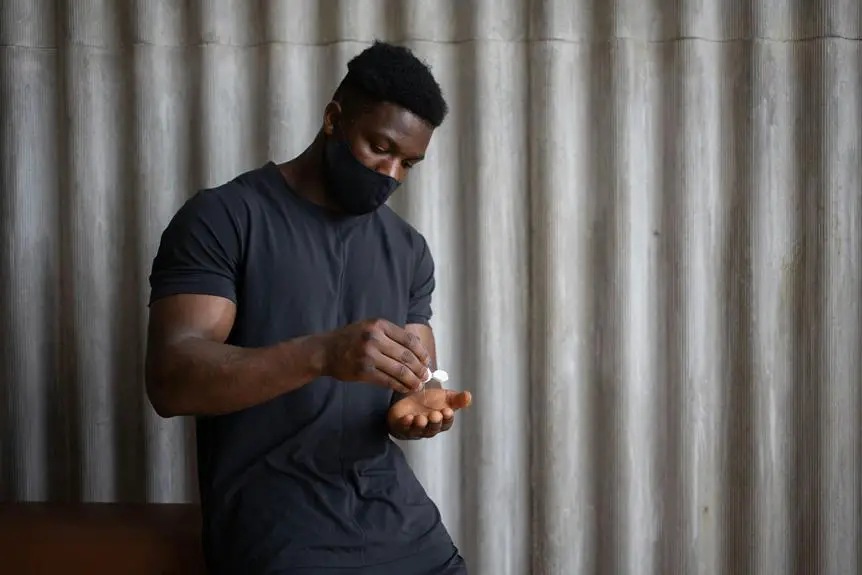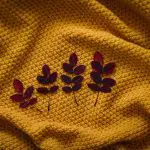When you're looking to stiffen fabric for a project, using gel medium can be an effective solution. Start by preparing your fabric properly; washing and drying it ensures the medium adheres well. As you apply the gel, you'll want to pay attention to technique to avoid any mess. Once you've coated the fabric, the drying and curing process is crucial for achieving the desired stiffness. But what specific tips can enhance your results and make your project stand out?
Table of Contents
Key Takeaways
- Choose natural fibers like cotton or linen for optimal results and pre-wash them gently without fabric softeners.
- Apply gel medium evenly using a brush or sponge, working in small sections to avoid pooling.
- Allow the fabric to dry in a well-ventilated area; drying time varies based on thickness and humidity.
- Cure the fabric for at least 24 hours after drying to maximize hardness and durability.
Understanding Gel Medium
Gel medium is a versatile art supply that can transform fabric into a stiff, structured material for your creative projects. This thick, acrylic-based medium not only enhances the texture and durability of your fabric but also acts as a strong adhesive. When you apply gel medium to the fabric, it seeps into the fibers, creating a firm hold that keeps your designs intact.
You'll find gel medium available in various finishes, such as gloss, matte, and satin. Each finish offers a different effect, so you can choose one that aligns with your artistic vision. It dries clear, making it perfect for layering and mixed media projects. Plus, gel medium is water-resistant once dry, ensuring your creations can withstand some exposure to moisture.
Using gel medium is straightforward; just brush it evenly across your fabric and let it dry thoroughly. You can also mix it with paint for added color and texture. The possibilities are endless, whether you want to create sculptures, embellish clothing, or make home décor items. Understanding how gel medium works will empower you to explore new creative avenues with your fabric projects.
Preparing Your Fabric
Before applying gel medium, you'll want to wash and dry your fabric to remove any dirt or sizing that could interfere with adhesion. This step is crucial for ensuring that the gel medium bonds effectively with the fibers, giving you the best results in your stiffening project.
Here are three tips to help you prepare your fabric:
- Choose the Right Fabric: Opt for natural fibers like cotton or linen, as they tend to work best with gel medium. Synthetic fabrics may not absorb the medium as well.
- Pre-Wash: Use a gentle detergent and wash your fabric in warm water. Avoid using fabric softeners, as they can leave a residue that hinders adhesion.
- Dry Properly: After washing, dry your fabric either in the dryer or air dry it completely. Ensure it's wrinkle-free, as any creases can affect how the gel medium applies.
Application Techniques
To achieve the best results, apply the gel medium evenly to your fabric using a brush or sponge for smooth coverage. Start by choosing a clean workspace and laying your fabric flat. Dip your brush or sponge into the gel medium, making sure not to oversaturate it. Then, work in small sections, spreading the medium evenly to avoid pooling.
Here's a quick reference table to help you with different application techniques:
| Technique | Tool Used | Best For |
|---|---|---|
| Brushing | Flat Brush | Large areas |
| Dabbing | Sponge | Textured surfaces |
| Spraying | Spray Bottle | Delicate fabrics |
| Stippling | Stippling Brush | Detailed designs |
Whichever technique you choose, ensure consistent pressure and movement to prevent streaks. Once you've coated the fabric, allow it to absorb the medium fully before moving on to the next step. This careful application will give your project the best chance to hold its shape and stay stiffened. Remember, practice makes perfect, so don't hesitate to experiment!
Drying and Curing Process
Allowing the fabric to dry and cure properly is essential for achieving a durable, stiffened finish. After applying the gel medium, you'll want to ensure that your fabric is placed in an environment conducive to drying. Here are three key steps to follow during the drying and curing process:
- Air Circulation: Place your fabric in a well-ventilated area. Good airflow helps the gel medium to dry evenly and prevents any damp spots that could affect the stiffness.
- Drying Time: Be patient. Depending on the thickness of the gel medium and the humidity in your environment, drying can take anywhere from a few hours to a full day. Check the fabric periodically, but resist the urge to rush the process.
- Curing Time: After the fabric feels dry to the touch, allow it to cure for at least 24 hours. Curing enables the gel medium to reach its maximum hardness and durability, ensuring your fabric maintains its shape when used.
Following these steps will help you achieve the best results for your stiffened fabric projects.
Tips for Best Results
Once your fabric has dried and cured properly, implementing a few tips can help you achieve the best results with your gel medium project. First, always mix your gel medium thoroughly before application. This ensures an even consistency and prevents clumping. Next, consider using a brush or sponge for application; this can help you control the amount of gel and reduce streaks.
When applying, work in thin layers. Multiple thin layers will give you a more flexible and durable finish than one thick layer. After applying each layer, allow it to dry completely before adding the next. This patience pays off!
Lastly, store your finished project in a cool, dry place. Excessive humidity can compromise the stiffness and integrity of your fabric.
Here's a quick reference table to guide you:
| Tip | Purpose |
|---|---|
| Mix thoroughly | Ensures even consistency |
| Use brush or sponge | Controls application and reduces streaks |
| Apply in thin layers | Provides flexibility and durability |
Frequently Asked Questions
Can Gel Medium Be Used on All Types of Fabric?
You can use gel medium on various fabrics, but it's best to test it first. Some materials, like delicate silks, might not hold up well, while sturdier fabrics often respond positively. Always experiment before committing!
Is Gel Medium Washable After It Dries?
Yes, gel medium isn't washable after it dries. Once it sets, it forms a durable bond, making your project water-resistant. However, it's always best to test on a small area first to ensure compatibility.
How Can I Remove Gel Medium From Fabric?
To remove gel medium from fabric, gently scrape off excess with a knife or credit card. Then, wash the fabric in warm water with soap, repeating as necessary until the gel is completely gone.
Will Gel Medium Change the Color of My Fabric?
Yes, gel medium can change your fabric's color, especially if it's transparent or tinted. It's best to test it on a small fabric piece first to see how it reacts before applying it widely.
Can Gel Medium Be Mixed With Paint for Fabric Stiffening?
Yes, you can mix gel medium with paint for fabric stiffening. This combination enhances color while providing structure. Just make sure to test it on a small fabric piece first to see how it reacts.
- How Does Ring Spun Cotton Affect Garment Fit and Shape Retention? - August 13, 2024
- What Are the Challenges in Producing Ring Spun Cotton? - August 13, 2024
- Is Ring Spun Cotton Suitable for Plus-Size Clothing? - August 13, 2024






